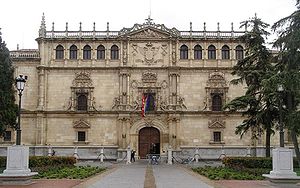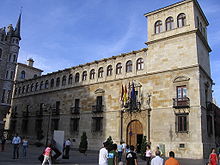
Renaissance architecture is the European architecture of the period between the early 15th and early 16th centuries in different regions, demonstrating a conscious revival and development of certain elements of ancient Greek and Roman thought and material culture. Stylistically, Renaissance architecture followed Gothic architecture and was succeeded by Baroque architecture and neoclassical architecture. Developed first in Florence, with Filippo Brunelleschi as one of its innovators, the Renaissance style quickly spread to other Italian cities. The style was carried to other parts of Europe at different dates and with varying degrees of impact.

Úbeda is a municipality of Spain located in the province of Jaén, Andalusia.

The Cathedral of Saint Mary of Burgos is a Catholic church dedicated to the Virgin Mary located in the historical center of the Spanish city of Burgos. Its official name is Santa Iglesia Catedral Basílica Metropolitana de Santa María de Burgos.

Santa María de Regla de León Cathedral is a Catholic church, the episcopal see of the diocese of León in the city of León, Castile and León, north-western Spain, consecrated under the name of the Virgin Mary. It was the first monument declared by the Royal Order of Spain on August 28, 1844.

The Alcázar of Seville, officially called Royal Alcázar of Seville, is a historic royal palace in Seville, Spain. It was formerly the site of the Islamic-era citadel of the city, begun in the 10th century and then developed into a larger palace complex by the Abbadid dynasty and the Almohads. After the Castilian conquest of the city in 1248, the site was progressively rebuilt and replaced by new palaces and gardens. Among the most important of these is a richly-decorated Mudéjar-style palace built by Pedro I during the 1360s.

Plateresque, meaning "in the manner of a silversmith", was an artistic movement, especially architectural, developed in Spain and its territories, which appeared between the late Gothic and early Renaissance in the late 15th century, and spread over the next two centuries. It is a modification of Gothic spatial concepts and an eclectic blend of Mudéjar, Flamboyant Gothic and Lombard decorative components, as well as Renaissance elements of Tuscan origin.

Baeza is a city and municipality of Spain belonging to the province of Jaén, in the autonomous community of Andalusia. It is part of the comarca of La Loma. The present name was established in Roman times as Vivatia, then Biatia by the Visigoths, Bayyasa by the Moors from the 8th century onwards; until it became Baeza.

Diego Siloe (anglicized) or Diego de Siloé was a Spanish Renaissance architect and sculptor, progenitor of the Granadan school of sculpture. He developed the majority of his work in Andalusia.

The Isabelline style, also called the Isabelline Gothic, or Castilian late Gothic, was the dominant architectural style of the Crown of Castile during the reign of the Catholic Monarchs, Queen Isabella I of Castile and King Ferdinand II of Aragon in the late-15th century to early-16th century. The Frenchman Émile Bertaux named the style after Queen Isabella.

Spanish architecture refers to architecture in any area of what is now Spain, and by Spanish architects worldwide. The term includes buildings which were constructed within the current borders of Spain prior to its existence as a nation, when the land was called Iberia, Hispania, or was divided between several Christian and Muslim kingdoms. Spanish architecture demonstrates great historical and geographical diversity, depending on the historical period. It developed along similar lines as other architectural styles around the Mediterranean and from Central and Northern Europe, although some Spanish constructions are unique.

Granada Cathedral, or the Cathedral of the Incarnation, is a Roman Catholic church in the city of Granada, capital of the province of the same name in the Autonomous Region of Andalusia, Spain. The cathedral is the seat of the Archdiocese of Granada. Like many other cathedrals in Andalusia, it was built on top of the city's main mosque after the reconquest of Granada.

Spanish Renaissance architecture was that style of Renaissance architecture in the last decades of the 15th century. Renaissance evolved firstly in Florence and then Rome and other parts of the Italian Peninsula as the result of Renaissance humanism and a revived interest in Classical architecture. In Spain, the Renaissance began to be grafted to Gothic forms as mathematicians and engineers rediscovered building as one of the technological sciences. In the time of King Felipe II (1556–1589), the Renaissance influence expanded throughout the territory thanks to the dissemination of architectural treatises.

Vázquez de Molina Square, situated in Úbeda (Jaén), in the Autonomous Region of Andalusia (Spain), is one of the best examples of Renaissance architecture in Spain. The Spanish Renaissance architectural value of this square was one of the motives for UNESCO's decision to declare Úbeda a World Heritage site in July 2003.

The Colegio de San Gregorio is an Isabelline style building located in the city of Valladolid, in Castile and León, Spain, it was formerly a college and now is housing the Museo Nacional de Escultura museum. This building is one of the best examples of the architectural style known as Isabelline, which is the characteristic architectural style of the Crown of Castile region during the Catholic Monarchs' reign.

Guadix Cathedral, Cathedral of Guadix, or Cathedral of the Incarnation is a Roman Catholic church in Guadix, province of Granada, Spain. Construction of the building began in the 16th century and was completed in the mid-18th century. It is in the Baroque style.

Felipe Bigarny, also known as Felipe Vigarny, Felipe Biguerny or Felipe de Borgoña, etc. and sometimes referred to as El Borgoñón, was a sculptor born in Burgundy (France) but who made his career in Spain and was one of the leading sculptors of the Spanish Renaissance. He was also an architect.

The Cathedral of Sigüenza, officially Catedral de Santa María de Sigüenza, is the seat of the bishop of Sigüenza, in the town of Sigüenza, in Castile-La Mancha, Spain. It was declared Bien de Interés Cultural in 1931.

The Primatial Cathedral of Saint Mary of Toledo, otherwise known as Toledo Cathedral, is a Roman Catholic church in Toledo, Spain. It is the seat of the Metropolitan Archdiocese of Toledo.

Alonso de Covarrubias was a Spanish architect and sculptor of the Renaissance, active mainly in Toledo.
The Monastery de Santiago de Uclés is in the Spanish town of Uclés in Castile-La Mancha and was built by the Order of Santiago, whose main headquarters was in that town.
























